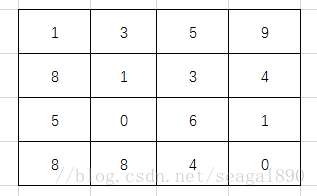JAVA算法:棋盘走法、方格走法常见算法问题汇总
问题一:方格从左上角走到右下角的走法数
给定一个m*n的方格,机器人只能向右走或向下走,求机器人从方格左上角走到右下角共有多少种走法。
对于2*2的方格有两种走法,3*3的方格有6种走法,求对m*n的方格有多少种走法。
算法分析

算法设计
package com.bean.algorithm.matrix;
public class CountPath {
/*
* 走方格问题:从左上角走到右下角的路径数量
* 当只有1个格子时:可以看作m=n=1时,其实没有可走的路径,记为0;
* 当只有2个格子时,无论是横着放置,还是竖着放置,路径数一样的。
* 为什么?横着放置时,表示只能一直从左向右走;
* 竖着放置时,表示只能一直从上向下走。
* 当有4个格子时:可走的路径为2.
* 当有6个格子时,可走的路径为3.
* 找找规律。
*/
public static int countMatrixPath(int m, int n) {
/*
* 开辟一个动态数组dp;dp数组的大小和原方格大小相同。
* 定义dp[i][j]表示从左上角的格子(原点或者起点)走到nums[i][j]的格子共有多少种走法。
* 首先分析题目的状态转移方程:因为机器人只能向右或向下走,
* 对于非边界的每一个格子nums[i][j],都有:dp[i][j]=dp[i-1][j]+dp[i][j-1]
* 然后考虑边界条件:
* 当i=0时,机器人只能向右走,
* 当j=0时,只能向下走,
* 所以对于边界点nums[i][j]有,
* 当i=0时,有dp[i][j]=dp[i][j-1];(表示当前位置是从左向右走过来的)
* 当j=0时,有dp[i][j]=dp[i-1][j];(表示当前位置是从上向下走过来的)
*
* */
int[][] dp = new int[m][n];
for (int i = 0; i < m; i++) {
for (int j = 0; j < n; j++) {
if (i != 0 || j != 0) {// 避免i,j同时为0,数组下标越界
if (i == 0) {//边界条件:表示从左向右走
dp[i][j] = dp[i][j - 1];
}
else if (j == 0) {//边界条件:表示从上向下走
dp[i][j] = dp[i - 1][j];
}
else {
//对于非边界上的格子
dp[i][j] = dp[i][j - 1] + dp[i - 1][j];
}
} else
dp[i][j] = 1;
}
}
//根据dp[i][j]的定义,其表示从左上角的格子(起点)走到nums[i][j]的格子共有多少种走法。
//返回dp[m-1][n-1]的值。
return dp[m - 1][n - 1];
}
public static void main(String[] args) {
// TODO Auto-generated method stub
int M = 4;
int N = 3;
int numbersofPath = countMatrixPath(M, N);
System.out.println("Numbers of Path is: " + numbersofPath);
}
}
输出运行结果:
Numbers of Path is: 10
问题二:方格中的值表示某种意义,从左上角走到右下角时求最大值或者最小值的路径
例如:给定一个矩阵m,从左上角开始每次只能向右或者向下走,最后到达右下角的位置,路径上所有的数字累加起来就是路径和,返回所有的路径中最小的路径和。
算法分析


算法设计
package com.bean.algorithmexec;
/*
* https://blog.csdn.net/seagal890/article/details/88603064
* */
public class MatrixPath {
/*
* 给定一个矩阵m,从左上角开始每次只能向右或者向下走,最后到达右下角的位置,
* 路径上所有的数字累加起来就是路径和,返回所有的路径中最小的路径和。
* 例如:
* 1 3 5 9
* 8 1 3 4
* 5 0 6 1
* 8 8 4 0
* 路径 1,3,1, 0,6,1,0 是所有路径中路径和最小的,所以返回12。
* */
/*
* 计算方法
* */
public static int minPathSum(int [][] m) {
if(m==null || m.length==0 || m[0]==null || m[0].length ==0) {
return 0;
}
int row=m.length;
int col=m[0].length;
int[][] dp=new int[row][col];
dp[0][0] = m[0][0];
for(int i=1;i<row;i++) {
dp[i][0] = dp[i-1][0]+m[i][0];
}
for(int j=1;j<col;j++) {
dp[0][j] = dp[0][j-1]+m[0][j];
}
for(int i=1;i<row;i++) {
for(int j=1;j<col;j++) {
dp[i][j] = Math.min(dp[i-1][j], dp[i][j-1])+m[i][j];
}
}
return dp[row-1][col-1];
}
/*
* 创建一个 M*N的矩阵,并赋予行和列随机整数值,元素的取值范围在1-10之间。
* */
public static int[][] createMatrix(int m, int n) {
int [][] matrix=new int[m][n];
int seed=0;
for(int i=0;i<m;i++) {
for(int j=0;j<n;j++) {
seed=(int) ((Math.random()*10)+1);
matrix[i][j]=seed;
}
}
return matrix;
}
/*
* 输出矩阵
* */
public static void printMatrix(int[][] matrix) {
for(int i=0;i<matrix.length;i++) {
for(int j=0;j<matrix[0].length;j++) {
System.out.print(matrix[i][j]+"\t");
}
System.out.println();
}
}
public static void main(String[] args) {
// TODO Auto-generated method stub
int[][] matrix=createMatrix(4,4);
printMatrix(matrix);
int sum=minPathSum(matrix);
System.out.println("sum = "+sum);
}
}
输出运行结果:(矩阵值是随机生成的)
7 2 8 3
10 3 8 3
4 9 5 3
8 10 4 8
sum = 34
问题三 LeetCode 62. Unique Paths
Unique Paths 原题链接:https://leetcode.com/problems/unique-paths/description/
Unique Paths II 原题链接:https://leetcode.com/problems/unique-paths-ii/description/
62. Unique Paths
A robot is located at the top-left corner of a m x n grid (marked ‘Start’ in the diagram below).
The robot can only move either down or right at any point in time. The robot is trying to reach the bottom-right corner of the grid (marked ‘Finish’ in the diagram below).
How many possible unique paths are there?
参考博文:https://blog.csdn.net/seagal890/article/details/79781703 解决
问题四 LeetCode 63. Unique Paths II
类似的问题是,行进路径上设置了一些障碍,而障碍是不可走的。
63. Unique Paths II
Follow up for “Unique Paths”:
Now consider if some obstacles are added to the grids. How many unique paths would there be?
An obstacle and empty space is marked as 1 and 0 respectively in the grid.
For example,
There is one obstacle in the middle of a 3x3 grid as illustrated below.
[
[0,0,0],
[0,1,0],
[0,0,0]
]
The total number of unique paths is 2.
Note: m and n will be at most 100.
63题和62题类似,不同的是设置了 obstacle,当遇到obstacle时,此路不同。
解题思路仍然是使用DP动态规划算法。无非对于dp数组元素,在obstacle位置将器值置位0即可。
需要增加一些判断条件。
算法设计
当遇到障碍时:dp[i][j] = 0;
当不是障碍时:dp[i][j] = dp[i - 1][j] + dp[i][j - 1];
public static int uniquePathsWithObstacles(int[][] obstacleGrid) {
//获取被处理数组的维度,m行n列
int m = obstacleGrid.length;
int n = obstacleGrid[0].length;
if(m==0 || n==0) return 0;
//计算时间,即如果左上角的元素值为1,直接返回0。
if(obstacleGrid[0][0]==1) return 0;
//DP(Dynamic Programming)数组为s,s与被处理的二维数组具有相同的行和列数
int[][] dp = new int[m][n];
//用dp[i][j]表示路径数
//当方格的左上角和右下角(第一个元素值为1时和最后一个元素值为1时,路径都为0)
dp[0][0] = obstacleGrid[0][0] == 0 ? 1 : 0;
if (dp[0][0] == 0)
return 0;
for (int i = 0; i < m; i++) {
for (int j = 0; j < n; j++) {
if (obstacleGrid[i][j] == 1)
//如果是路障,则dp[i][j]=0
dp[i][j] = 0;
else if (i == 0) {
if (j > 0)
dp[i][j] = dp[i][j - 1];
} else if (j == 0) {
if (i > 0)
dp[i][j] = dp[i - 1][j];
} else
//如果不是路障,则状态方程为dp[i][j] = dp[i - 1][j] + dp[i][j - 1]
dp[i][j] = dp[i - 1][j] + dp[i][j - 1];
}
}
return dp[m - 1][n - 1];
}问题五 马走8×8棋盘问题
参考博文:https://blog.csdn.net/seagal890/article/details/79339757
经典问题:给定一个8×8棋盘,马从任意位置开始,走“日”字,不重复的走完棋盘上的所有位置。
如图所示:

假设从坐标为(2,2)的点开始走,有8个方向可以选择。所以每次都要依据这最多8个方向进行选择。
贪心算法不是对所有问题都能得到整体最优解,关键是贪心策略的选择,选择的贪心策略必须具备无后效性,即某个状态以前的过程不会影响以后的状态,只与当前状态有关。在处理马踏棋盘问题时,每次在至多8个可选的方向中,首先通过验证其中一个方向可以成功。贪心算法同样是试探至多的八个可能的出口,但是八个出口的排序并非按照前述的顺时针,而是按照每个可能出口的进一步出口数的递增排序,所以每次先试探的总是进一步出口较少的出口,能够给之后的出口更多的选择,因此贪心算法是比较高效的,而且它不回溯。